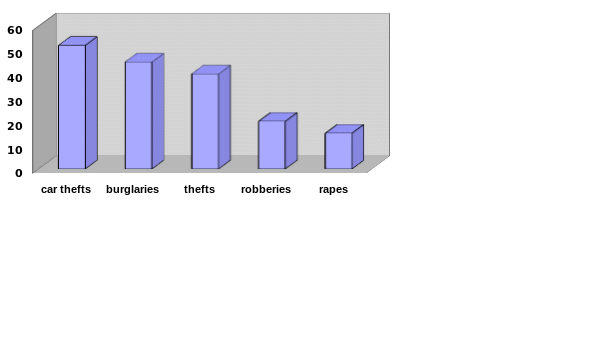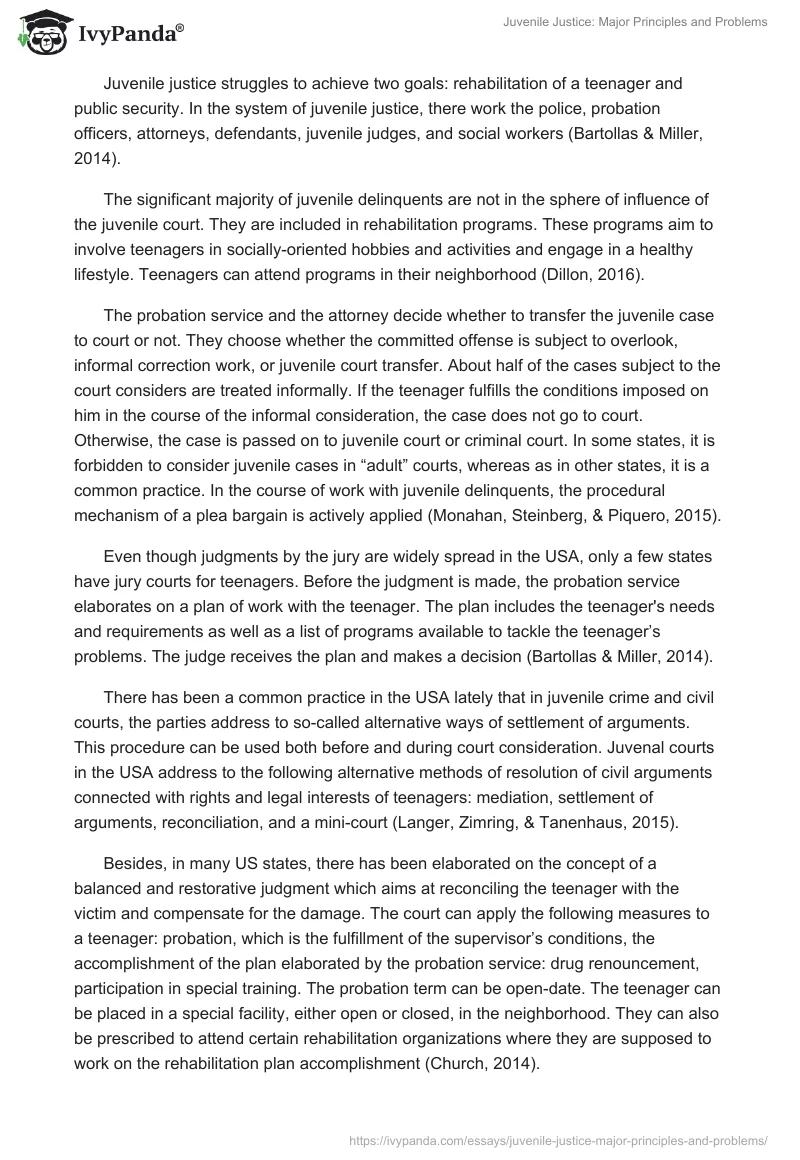Abstract
This work considers juvenile justice. It dwells upon its major principles and problems. The juvenile justice system has been changing throughout the years. However, its main peculiarity is that it bases on the idea of rehabilitation rather than punishment. Juvenile delinquents are unlikely to be brought before the “adult” court in the majority of the US states. The juvenile court aims to guarantee care, security, and protection and help the teenager to restore the position in society. The system strives to reconcile the criminal and the victim. Apart from discussing qualitative data, the work provides some official statistics figures on the juvenile crime rate.
Juvenile Justice
According to the statistics, juvenile crime happens to be a serious issue. However, it has been accepted that teenagers cannot be judged based on the same principles as for adults. Therefore, the juvenile justice system has been worked out to considered juvenile cases and help teenagers to return to the right mode of life without crimes.
The most important ideas of the fatherly concern doctrine proved to be the principles of guardianship and education. The juvenile justice did not aim to punish the offender but guarantee care, security, and protection which corresponded to parental responsibility about the upbringing of children. Acknowledging a proper upbringing as its aim, the fatherly concern doctrine did not always presuppose a punishment. Thus, the doctrine did not initially accept a proper justice procedure in juvenile courts. However, later, some amendments were made. The basic ideas of the fatherly concern doctrine were reflected in both the states’ juvenile codes and federal laws concerning juvenile justice and juvenile crime prevention. In the majority of US states, the system of juvenile justice is independent of the “adult” justice. In many states, it is controlled by social services (Bartollas & Miller, 2014).
Juvenile justice struggles to achieve two goals: rehabilitation of a teenager and public security. In the system of juvenile justice, there work the police, probation officers, attorneys, defendants, juvenile judges, and social workers (Bartollas & Miller, 2014).
The significant majority of juvenile delinquents are not in the sphere of influence of the juvenile court. They are included in rehabilitation programs. These programs aim to involve teenagers in socially-oriented hobbies and activities and engage in a healthy lifestyle. Teenagers can attend programs in their neighborhood (Dillon, 2016).
The probation service and the attorney decide whether to transfer the juvenile case to court or not. They choose whether the committed offense is subject to overlook, informal correction work, or juvenile court transfer. About half of the cases subject to the court considers are treated informally. If the teenager fulfills the conditions imposed on him in the course of the informal consideration, the case does not go to court. Otherwise, the case is passed on to juvenile court or criminal court. In some states, it is forbidden to consider juvenile cases in “adult” courts, whereas as in other states, it is a common practice. In the course of work with juvenile delinquents, the procedural mechanism of a plea bargain is actively applied (Monahan, Steinberg, & Piquero, 2015).
Even though judgments by the jury are widely spread in the USA, only a few states have jury courts for teenagers. Before the judgment is made, the probation service elaborates on a plan of work with the teenager. The plan includes the teenager’s needs and requirements as well as a list of programs available to tackle the teenager’s problems. The judge receives the plan and makes a decision (Bartollas & Miller, 2014).
There has been a common practice in the USA lately that in juvenile crime and civil courts, the parties address to so-called alternative ways of settlement of arguments. This procedure can be used both before and during court consideration. Juvenal courts in the USA address to the following alternative methods of resolution of civil arguments connected with rights and legal interests of teenagers: mediation, settlement of arguments, reconciliation, and a mini-court (Langer, Zimring, & Tanenhaus, 2015).
Besides, in many US states, there has been elaborated on the concept of a balanced and restorative judgment which aims at reconciling the teenager with the victim and compensate for the damage. The court can apply the following measures to a teenager: probation, which is the fulfillment of the supervisor’s conditions, the accomplishment of the plan elaborated by the probation service: drug renouncement, participation in special training. The probation term can be open-date. The teenager can be placed in a special facility, either open or closed, in the neighborhood. They can also be prescribed to attend certain rehabilitation organizations where they are supposed to work on the rehabilitation plan accomplishment (Church, 2014).
According to the official data, the juvenile crime rate increases by an average of 8% annually. Juvenile criminals commit 52% of car thefts, 45% of burglaries, 40% of miscellaneous thefts, 20% of robberies, and 15% of rapes (Juvenile Crime (figure 1)). It is admitted to be a serious problem for the country (Sickmund & Puzzanchera, 2014).
Juvenile Crimes

Social services tend to get involved in the organization of surveys for teenagers. Questionnaires should be univocal. For instance, “What will you do if you see your friend shoplifting?” is unlikely to result in reliable statistics, as the respondent might be an accessory and would not tell the truth.
In conclusion, it is necessary to admit that the juvenile crime rate is high in the US. However, the juvenile justice system aims at rehabilitation rather than at punishment. The major principle is to guarantee care, security, and protection.
References
Bartollas, C., & Miller, S. J. (2014). Juvenile justice in America. Boston, MA: Pearson.
Church, W. T. (2014). Juvenile justice sourcebook. Oxford: Oxford University Press.
Dillon, M. E. (2016). Juvenile Justice and adolescent health: Crime, punishment and life trajectory. International Handbook on Adolescent Health and Development, 241-265.
Langer, M., Zimring, F. E., & Tanenhaus, D. S. (2015). Juvenile justice in global perspective. New York, NY: New York University Press.
Monahan, K., Steinberg, L., & Piquero, A. R. (2015). Juvenile justice policy and practice: A developmental perspective. Crime and Justice, 44(1), 577-619.
Sickmund, M., & Puzzanchera, C. (2014). Juvenile offenders and victims: 2014 national report. Web.


